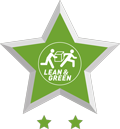Home
Vlakglas Recycling Nederland. Together we make glass infinite.
Recycling is not a choice, but a necessity. After all, the depletion of the earth s raw materials has been a growing problem for many years. Our supplies of oil, gas, minerals and metals are being depleted so fast that it is uncertain how much more we can extract from the earth. Recycling is part of the solution to this issue. It is worth separating and collecting any materials that we can in order to recycle them. The same applies to waste sheet glass.
What is sheet glass?
Sheet glass is an umbrella term for the types of glass used in residential and utility buildings (such as offices, health centres and other business premises). It is used in items such as windows and doors. But actually sheet glass has endless applications. The enormous range of properties that the glass can be given during the manufacturing process make it an extremely versatile material. Glass can be used to improve both the interior and exterior appearance of buildings.
The construction sector - both residential and commercial - generates many thousands of tons of waste glass every year. Sustainable demolition and renovation techniques mean that more and more used sheet glass is now being separated at source for recycling. The foundation Vlakglas Recycling Nederland is committed to ensuring that the collection and recycling of waste sheet glass occurs consistently and systematically.
Who is Vlakglas Recycling Nederland?
In 2000, Dutch sheet glass manufacturers launched an initiative to set up a voluntary recycling scheme in order to meet their responsibilities as producers of sheet glass. Three organizations participated in the initiative: the Manufacturers of Double Glazing in the Netherlands (FIGIN), wholesalers and importers of sheet glass, who were collectively represented by the Glass Branch Organization (GBO) and the Dutch Glass Federation (NGF). To that end they conducted an experiment in the northern provinces of the Netherlands. On the basis of the favourable results of that experiment, the Ministry of Housing, Spatial Planning and Environment gave its approval to the system and the method used for financing it. Vlakglas Recycling Nederland was founded in 2002.
This non-profit organization coordinates all the activities associated with recycling and collecting waste glass in an efficient, environmentally friendly manner and at the lowest possible cost. It supports and coordinates the participating companies and agencies; it also oversees the collection of the recycling fee and acts as an information point for all those involved. Furthermore, the foundation promotes awareness of and enthusiasm for recycling glass. The government has also demonstrated its commitment to this process by legislating for the sheet glass recycling levy for double glazing.
What is the recycling fee?
Vlakglas Recycling Nederland is financed by means of a recycling fee. This amount to € 0.30 for every m2 of insulated glass that is produced in or imported into the Netherlands. All producers and/or importers of double glazing who sell their products in the Netherlands are required to pay the recycling fee. This is the result of a policy decision by the Ministry of Infrastructure and Water Management. This Ministry has declared that the agreement on the recycling fee is legally binding. This decision was published in the Staatscourant (Government Gazette) of 28 June 2016.
Vlakglas Recycling Nederland is responsible for collecting the recycling fee. The fee is actually collected by the Independent Administration for Sheet Glass (OAV). The recycling fee is collected on a quarterly basis. Companies who import double glazing in small quantities or only sporadically are given the chance to pay the levy annually rather than quarterly in order to reduce the administrative burden. Figures can be submitted either on paper or using a secure website. After payment for the relevant year has been received, each participant receives a certificate of participation.
Cradle-to-cradle and sheet glass: a good match
The idea behind the separate collection and recycling of sheet glass is the cradle-to-cradle philosophy: the principle that after use, materials should be fully recyclable for use in other products. The term cradle-to-cradle is meant to emphasize that the life cycle of a product should not be seen in terms of cradle-to-grave ; rather, after products have been used, they should become the raw materials for new products.
Recycling glass is one case where the cradle-to-cradle principle can be implemented with relative ease. There are three reasons for this: glass is - with the exception of glass wool - completely reusable, recycling glass does not result in any loss of quality, and there is very little waste. This creates a loop or cycle, which is known as waste equals food . But in order for this cycle to work properly, we need to separate biological and technical nutrients (such as glass, metals and plastics) properly. This is the logic behind a nationwide system of collecting and recycling glass waste.
What happened to the waste glass fragments in 2021?
- Sheet-glass industry - 8,40%
- Insulation products - 29,20%
- Packaging glass industry - 52,30%
Others - 0,80%
One of the aims of Vlakglas Recycling Nederland is to achieve that 20% of our collected waste sheet glass will be used in the sheet glass production.
The many advantages of recycling sheet glass
The system of collection is intended for all those who work with waste glass: painters, glaziers, demolition companies, contractors, glass suppliers, glass processors, glass manufacturers and so on. Because the organization is nation-wide, it brings together all parties to cooperate effectively: companies involved in supplying glass, the collection network and the recycling companies. This saves money.
Dumping sheet glass in landfill as normal waste actually costs the dumper money. Plus, reusing waste glass reduces the amount of waste that has to be processed by landfill sites. In addition, recycling glass reduces the burden on our environment by reducing the need for fresh raw materials to produce new glass. One kilo of cullet can replace over a kilo of sodium carbonate and sand, the two main raw materials for glass. Recycling glass also saves energy and reduces CO2 emissions. Making new glass also requires a lot more energy than recycling old glass. This is because when clean glass cullet is used, the melting temperature in the furnace can actually be considerably lower. In fact, every 10% of cullet that is used in glass manufacturing reduces energy consumption by 2.5% and CO2 emissions by 5%.
The system of collection
Waste glass can be collected in various ways:
- Ad hoc (projects): Vlakglas Recycling Nederland can provide temporary containers for renovation or demolition projects. A small contribution towards the cost of these containers is required for this.
- Storage and transfer stations: A company can deposit waste sheet glass at one of Vlakglas Recycling Nederland s affiliated storage and transfer stations. A processing fee is charged.
- Collection points: Small amounts of sheet glass can be deposited free of charge at Vlakglas Recycling Nederland s collection points. These collection points can be found at selected glass resellers and producers, but also at a number of major waste recycling centres.
- Container rental: Companies can also hire a container for their own use on site.
- Waste parks: containers can be rented by waste parks so that small amounts of sheet glass waste can be deposited by consumers.
Clearly, it is important that the waste glass is clean when it is delivered to the collection points. Contaminated sheet glass is not recyclable and has to be disposed of as standard waste.
Read more about the total amount of collected sheet glass waste which we have collected the last years.
The glass cycle...
After collection, the waste sheet glass is transported by boat or truck to specialist recycling plants. There, the dirt is removed from the glass and it is processed into a material called cullet, which is made up of small pieces of cleaned recycled glass. This cullet can then be re-used in the glass industry.
All kinds of sheet glass are collected, including wire glass, laminated glass, coloured glass and double glazing. The recycling company processes all these types of glass into a final product that is made of 100% pure glass. The incoming waste sheet glass is stripped of any foil, iron or other contaminants. Then it is crushed to pieces of the right size. The pieces are then mixed to the specifications of the purchaser and delivered to glass industry as a high-quality, consistent, homogenous and reliable product. Finally, the glass cullet is delivered to customers who reuse it.
The main buyers of recycled glass are manufacturers of sheet glass (for windows), glass for packaging (bottles and jars), and insulation materials (glass wool). There are also some special niche markets, such as the tile industry, high-tech applications (such as glass filters) and a range of architectural applications. This is the glass cycle, the process by which waste sheet glass is processed into cullet that can be reused in the glass industry.
Recycling in figures
- If sheet glass is not collected separately, but disposed of as regular construction and demolition waste, this means a CO2 burden of 620 kilos.
- If 10% cullet is added to the mix of raw materials for glass production, 5% less CO2 is emitted.
- If 10% cullet is added to the mix of raw materials for glass production, 2.5% less energy is used.
- One kilo of cullet can replace about 1.2 kilos of fresh raw materials in glass production.
- Recycling 20 cm2 of glass saves energy equivalent to lighting a 60-watt light bulb for four hours.
- In 2021, Vlakglas Recycling Nederland collected 90,860 tonnes of waste sheet glass. This saves the equivalent of 10,539,760 kilos of CO2.
Downloads
Vlakglas Recycling Nederland, Collected 1.000.000.000 kg sheet glass waste - 2016
Vlakglas Recycling Nederland, Together we make glass infinite - 2012













